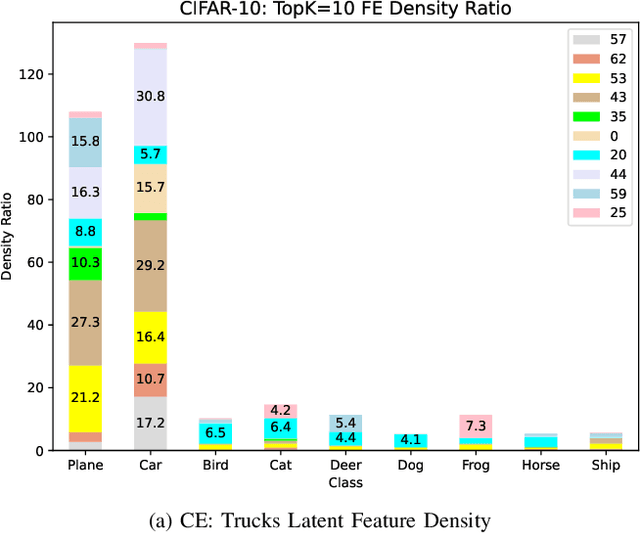Damien A. Dablain
The Hidden Influence of Latent Feature Magnitude When Learning with Imbalanced Data
Jul 14, 2024Abstract:Machine learning (ML) models have difficulty generalizing when the number of training class instances are numerically imbalanced. The problem of generalization in the face of data imbalance has largely been attributed to the lack of training data for under-represented classes and to feature overlap. The typical remedy is to implement data augmentation for classes with fewer instances or to assign a higher cost to minority class prediction errors or to undersample the prevalent class. However, we show that one of the central causes of impaired generalization when learning with imbalanced data is the inherent manner in which ML models perform inference. These models have difficulty generalizing due to their heavy reliance on the magnitude of encoded signals. During inference, the models predict classes based on a combination of encoded signal magnitudes that linearly sum to the largest scalar. We demonstrate that even with aggressive data augmentation, which generally improves minority class prediction accuracy, parametric ML models still associate a class label with a limited number of feature combinations that sum to a prediction, which can affect generalization.
Towards Understanding How Data Augmentation Works with Imbalanced Data
Apr 12, 2023Abstract:Data augmentation forms the cornerstone of many modern machine learning training pipelines; yet, the mechanisms by which it works are not clearly understood. Much of the research on data augmentation (DA) has focused on improving existing techniques, examining its regularization effects in the context of neural network over-fitting, or investigating its impact on features. Here, we undertake a holistic examination of the effect of DA on three different classifiers, convolutional neural networks, support vector machines, and logistic regression models, which are commonly used in supervised classification of imbalanced data. We support our examination with testing on three image and five tabular datasets. Our research indicates that DA, when applied to imbalanced data, produces substantial changes in model weights, support vectors and feature selection; even though it may only yield relatively modest changes to global metrics, such as balanced accuracy or F1 measure. We hypothesize that DA works by facilitating variances in data, so that machine learning models can associate changes in the data with labels. By diversifying the range of feature amplitudes that a model must recognize to predict a label, DA improves a model's capacity to generalize when learning with imbalanced data.
Interpretable ML for Imbalanced Data
Dec 15, 2022



Abstract:Deep learning models are being increasingly applied to imbalanced data in high stakes fields such as medicine, autonomous driving, and intelligence analysis. Imbalanced data compounds the black-box nature of deep networks because the relationships between classes may be highly skewed and unclear. This can reduce trust by model users and hamper the progress of developers of imbalanced learning algorithms. Existing methods that investigate imbalanced data complexity are geared toward binary classification, shallow learning models and low dimensional data. In addition, current eXplainable Artificial Intelligence (XAI) techniques mainly focus on converting opaque deep learning models into simpler models (e.g., decision trees) or mapping predictions for specific instances to inputs, instead of examining global data properties and complexities. Therefore, there is a need for a framework that is tailored to modern deep networks, that incorporates large, high dimensional, multi-class datasets, and uncovers data complexities commonly found in imbalanced data (e.g., class overlap, sub-concepts, and outlier instances). We propose a set of techniques that can be used by both deep learning model users to identify, visualize and understand class prototypes, sub-concepts and outlier instances; and by imbalanced learning algorithm developers to detect features and class exemplars that are key to model performance. Our framework also identifies instances that reside on the border of class decision boundaries, which can carry highly discriminative information. Unlike many existing XAI techniques which map model decisions to gray-scale pixel locations, we use saliency through back-propagation to identify and aggregate image color bands across entire classes. Our framework is publicly available at \url{https://github.com/dd1github/XAI_for_Imbalanced_Learning}
 Add to Chrome
Add to Chrome Add to Firefox
Add to Firefox Add to Edge
Add to Edge